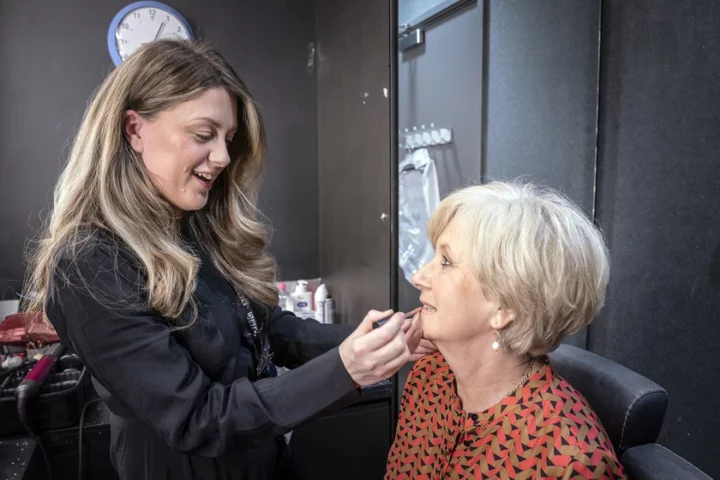Whether you’re in your 30s or your 60s, your skin probably doesn’t look and feel like it did at the age of 20 – and that’s OK.
But if you’ve barely upgraded the make-up you’ve been using for years, it might be time to do so.
“As we age, our skincare and make-up needs change, and it’s important to adapt our beauty routines to address the specific concerns that come with each decade,” says Co. Kildare-based make-up artist Suzie O’Neill, owner of vegan cosmetics company Ayu.
Over time, your skin loses elasticity and oils, so in all age groups solid skincare is key.
“Regardless of age, a good skincare routine is essential for a smooth make-up application,” O’Neill says. “Prioritise moisturising and using sunscreen daily.”
She advises using products rich in vitamins A, C and E – to protect the outermost layer from water loss in your 30s, a decade where “skin becomes more delicate and cell turnover is slowing down, making your complexion look dull”.
So how should we switch up our make-up in our 40s and beyond?
In your 40s
Collagen and elastin production naturally decrease during this period, leading to a reduction in skin firmness and elasticity in your 40s, O’Neill says. To combat this, she recommends incorporating a serum with ingredients like hyaluronic acid, peptides and retinol, which can help stimulate collagen production.
Foundation is the most important make-up upgrade to make at this period of your life. “Your 40s are the ideal time to switch to a foundation that is more hydrating and lighter than what you might have used in your 20s and 30s. Heavy, matte foundations tend to settle into fine lines and wrinkles, which can accentuate them. A hydrating and lighter foundation is a better choice as your skin may become drier and more mature.”
O’Neill advises using a moisturising lipstick or balm to keep lips hydrated, as they can start to become drier at this time in our lives.
“The cumulative effects of sun exposure can become more apparent in your 40s, leading to pigmentation issues, fine lines and potential sunspots,” she adds. So a broad-spectrum sunscreen is “non-negotiable”.
In your 50s
When it comes to make-up, your 50s may be a time when you opt for a more natural look. “A light to medium coverage foundation or a tinted moisturiser [will] not only provide a subtle, youthful glow, but also allow the natural character of the skin to shine through,” notes O’Neill.
“Less is often more at this stage.”
She recommends focusing on techniques that lift and brighten the eyes. “For example, tight-lining – applying eyeliner to the upper waterline – can make lashes appear thicker and eyes more prominent. Apply eye make-up with a light hand and choose softer, neutral shades that open up the eyes and give them a more refreshed appearance.”
It’s common for lips to appear to lose volume by our 50s, so O’Neill suggests using a lip liner in a shade closely matching your natural lip colour. “It can work wonders by creating the illusion of fuller, more voluptuous lips.
“Eyebrows and eyelashes tend to thin out as we age; filling in sparse brows with a brow pencil or powder and using volumising mascara can help restore the appearance of full, youthful brows and lashes.”
In your 60s and beyond
As you enter your 60s, you could opt for warmer hues.
“As our skin naturally loses some of its warmth and pigmentation, opting for a foundation with warmer undertones can help counteract any sallowness that may occur,” says O’Neill. “[But] choosing a foundation that matches your skin tone as closely as possible is essential.”
You also might notice an increase in pigmentation irregularities on your skin. “To even out pigmented skin, I’d recommend using a colour-correcting concealer for spots and discolourations (orange or peach-toned concealers can help neutralise dark spots) followed by a lightweight foundation or BB cream to even out skin tone,” she says.
“Use setting powders sparingly as they can emphasise fine lines. Opt for a finely milled, translucent powder applied lightly only where needed.”
And don’t be afraid to experiment with colour in your 60s. “Using more colour can be a great way to combat dullness that often accompanies ageing skin.
“Brighter shades of make-up, such as lipsticks, eyeshadows, and blush, can help liven up your complexion.”
Blush can help brighten up your skin, with O’Neill recommending cream versions as “they tend to blend more seamlessly and provide a dewy, hydrating finish”, and can be easily applied with your fingers.
“Just remember to choose shades that complement your skin tone and apply them sparingly for a natural flush,” she adds.
As you age, splurging on make-up isn’t a must, she says, but investing in high-quality make-up products that cater to your specific needs can be beneficial. “Look for products that provide essential hydration [and] achieve a luminous glow.
“The key is to enhance your natural beauty rather than mask it.”
Read MoreCharity boss speaks out over ‘traumatic’ encounter with royal aide
Ukraine war’s heaviest fight rages in east - follow live
Victorian dahlia show recreated at Stonehenge with thousands of flowers
Daily activities could help lower heart attack risk, study suggests
From tiredness to sweating – subtle warning signs something could be wrong with your heart

